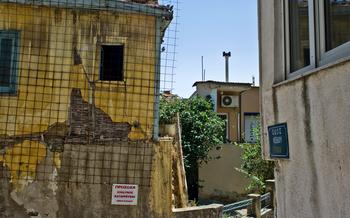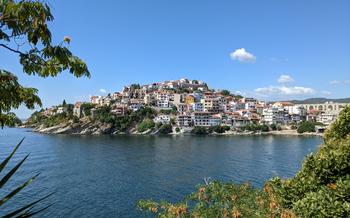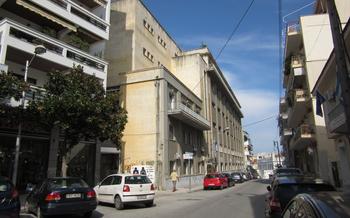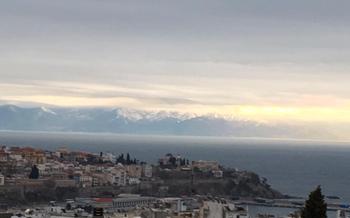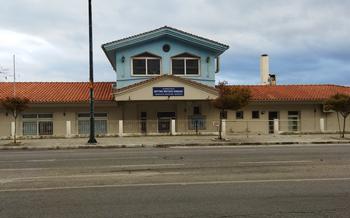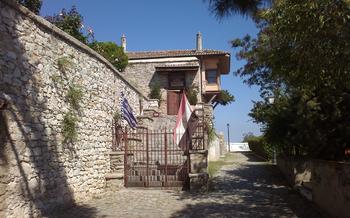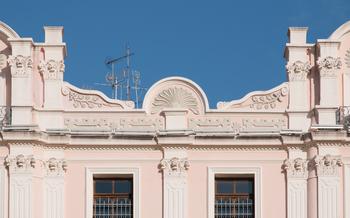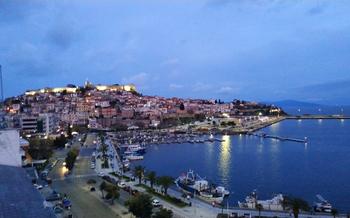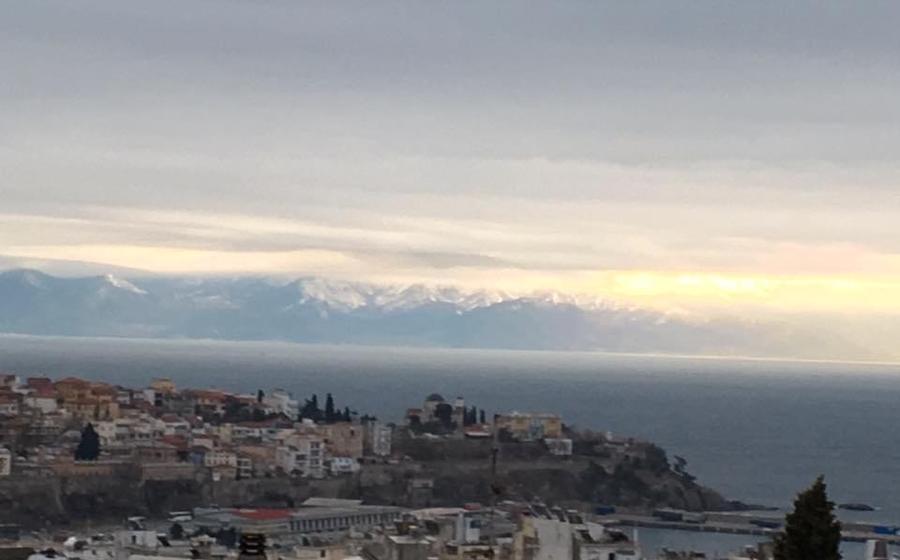
Old Meteorological Station Kavala
- Historical Significance
- Architectural Features
- Scientific Instruments
- Weather Observations
- Synoptic Charts: Tracking Weather Systems
- Climate Research
- Educational Value
- Tourist Attraction
- Interactive Exhibits
- Stunning Views
- Visitor Information
- Local Cuisine
- Combine with Other Attractions
- Photography Opportunities
- Insider Tip:
Historical Significance
The Old Meteorological Station in Kavala holds a significant place in the history of Greek meteorology. Established in the late 19th century, the station played a crucial role in weather forecasting and climate monitoring in the region. It was one of the first meteorological stations in Greece and contributed immensely to the development of the field. The station's dedicated staff diligently collected and analyzed weather data, providing valuable insights into local climate patterns and contributing to the advancement of meteorological science in the country.
Architectural Features
The Old Meteorological Station of Kavala stands as a testament to the fusion of architectural styles that prevailed during its construction. Its unique design showcases a blend of traditional Greek elements and influences from European architecture. The building's exterior features intricate stone carvings and decorative moldings, reminiscent of the neoclassical style popular in the 19th century. The symmetrical facade, with its central entrance flanked by arched windows, adds to the station's grandeur. Inside, the station's layout is both functional and aesthetically pleasing. The spacious rooms, with their high ceilings and large windows, allow for ample natural light, creating a bright and airy atmosphere. The station's design not only reflects its scientific purpose but also embodies the spirit of progress and modernization that characterized the era of its construction.
Scientific Instruments
The Old Meteorological Station of Kavala was equipped with a wide range of meteorological instruments, each serving a specific purpose in weather observation and data collection. These instruments played a crucial role in understanding local climate patterns and contributing to the development of meteorology.
Among the notable instruments at the station were thermometers for measuring air temperature, hygrometers for measuring humidity, and barometers for measuring atmospheric pressure. Anemometers were used to determine wind speed and direction, while rain gauges measured precipitation amounts. Sunshine recorders tracked the duration of sunshine, and cloud cover was observed and recorded manually.
In addition, the station was equipped with specialized instruments for upper-air observations. These included radiosondes, which were attached to balloons and released into the atmosphere to collect data on temperature, humidity, and pressure at different altitudes. Pilot balloons were also launched to track wind direction and speed at various heights.
The data collected from these instruments was meticulously recorded and analyzed by the station's staff. This information was then used to prepare weather forecasts, issue weather warnings, and contribute to the development of long-term climate records.
Weather Observations
The Old Meteorological Station in Kavala played a pivotal role in weather observations and monitoring. Its dedicated team of meteorologists meticulously recorded and analyzed a wide range of weather parameters. These observations included temperature, humidity, precipitation, wind speed and direction, visibility, and barometric pressure. Using advanced instruments, they measured and documented the fluctuations in these parameters throughout the day, creating a comprehensive dataset that served as a valuable resource for weather forecasting and climate studies.
The station's location, perched on a hill overlooking the Aegean Sea, offered a unique perspective for weather observations. Meteorologists could monitor weather patterns approaching from both the land and the sea, providing early warnings for storms, cyclones, and other significant weather events. The data collected at the station was meticulously recorded in logbooks and later digitized for analysis and archiving. These records have become an invaluable resource for climate researchers, helping to reconstruct past weather patterns and understand long-term climate trends.
Synoptic Charts: Tracking Weather Systems
Synoptic charts are graphical representations of weather conditions over a large area at a specific time. They are essential tools for meteorologists to track weather systems and predict weather patterns. The Old Meteorological Station in Kavala played a crucial role in the preparation of synoptic charts for the region.
Meteorologists at the station used various weather observations, including temperature, pressure, humidity, wind speed, and direction, to create these charts. The data was plotted on a map, with symbols and lines representing different weather conditions. By analyzing these charts, meteorologists could identify weather fronts, cyclones, anticyclones, and other weather systems.
The synoptic charts prepared at the Old Meteorological Station were used by forecasters to predict weather patterns and issue warnings for severe weather events. They were also shared with other meteorological stations in Greece and across Europe, contributing to a comprehensive understanding of weather conditions on a regional and continental scale.
Climate Research
The Old Meteorological Station in Kavala played a pivotal role in climate research initiatives, contributing to our understanding of climate change and variability. Scientists at the station meticulously collected long-term climate data, including temperature, humidity, precipitation, wind speed, and direction. These valuable records provided insights into past climate patterns and served as a baseline for studying climate change.
The station's involvement in climate research extended to international collaborations and participation in global climate monitoring programs. By sharing data and expertise, the station contributed to the global effort to understand and address climate-related challenges. Its contributions helped shape climate policies and mitigation strategies, ultimately aiming to protect the environment and ensure a sustainable future for generations to come.
Educational Value
The Old Meteorological Station in Kavala holds immense educational value, serving as a treasure trove of knowledge for students, researchers, and the general public alike. Educational programs and activities are meticulously crafted to foster a deeper understanding of meteorology and climate science, igniting a passion for these fields in the minds of young learners. The station's interactive exhibits provide a hands-on experience, allowing visitors to delve into the intricacies of weather patterns and climate change through engaging and immersive activities. By promoting awareness about these crucial scientific disciplines, the Old Meteorological Station empowers individuals to make informed decisions regarding environmental stewardship and sustainable practices.
Tourist Attraction
The Old Meteorological Station in Kavala has undergone a remarkable transformation, evolving from a scientific hub to a captivating tourist attraction. Today, it welcomes visitors from far and wide, eager to delve into the world of meteorology and climate science. Guided tours are available, providing an immersive experience as visitors explore the station's historic rooms and marvel at the intricate scientific instruments. Interactive exhibits enhance the tour, allowing visitors to engage with meteorology in a hands-on manner. The highlight of the visit is undoubtedly the ascent to the observation tower, which offers breathtaking panoramic views of Kavala and the surrounding landscape. From this vantage point, visitors can capture stunning photographs, creating lasting memories of their time at this unique and educational destination.
Interactive Exhibits
The Old Meteorological Station in Kavala features a range of interactive exhibits that provide visitors with an engaging and hands-on learning experience. These exhibits allow visitors to explore the fascinating world of meteorology and climate science in a fun and interactive way.
One of the highlights of the interactive exhibits is the weather simulator. This state-of-the-art simulator allows visitors to experience different weather conditions, such as thunderstorms, hurricanes, and tornadoes, in a safe and controlled environment. Visitors can adjust various parameters, such as wind speed, temperature, and humidity, to create their own unique weather scenarios.
Another popular exhibit is the climate change display. This interactive exhibit showcases the impacts of climate change on our planet, using interactive graphics, videos, and hands-on activities. Visitors can learn about the causes and consequences of climate change, and explore ways to reduce their carbon footprint and mitigate its effects.
The Old Meteorological Station also offers a variety of educational programs and workshops for students and the general public. These programs cover a wide range of topics, from basic meteorology to climate change and renewable energy. Visitors can participate in hands-on experiments, learn about the latest developments in weather forecasting, and gain a deeper understanding of the role of meteorology in our daily lives.
Whether you're a weather enthusiast, a science buff, or simply looking for a fun and educational experience, the Old Meteorological Station in Kavala is a must-visit destination. With its interactive exhibits, educational programs, and stunning views, the station offers a unique and unforgettable experience for visitors of all ages.
Stunning Views
The Old Meteorological Station is strategically positioned atop a hill, offering breathtaking panoramic vistas of Kavala and its picturesque surroundings. The observation tower, a prominent feature of the station, provides an elevated platform from which visitors can soak in the mesmerizing views. The city's vibrant cityscape, the shimmering Aegean Sea, and the lush green hills create a captivating tapestry that leaves visitors in awe. Whether you're a nature enthusiast, a photography buff, or simply someone who appreciates stunning scenery, the Old Meteorological Station promises an unforgettable visual experience. Capture the beauty of Kavala and its surroundings with your camera, and share your stunning photographs with the world.
Visitor Information
Planning a visit to the Old Meteorological Station in Kavala is easy and enjoyable. The station is open to the public daily, except for Mondays, from 10 am to 4 pm. Admission fees are minimal, ensuring accessibility for all visitors. The station is conveniently located within the city center, making it easy to reach by foot or public transportation. Visitors with disabilities can access the station through a designated entrance, and guided tours are available upon request. To enhance your visit, consider booking a guided tour led by experienced meteorologists who can provide in-depth insights into the station's history, instruments, and weather forecasting techniques. For more information, visit the official website of the Old Meteorological Station Kavala or contact the station directly.
Local Cuisine
After exploring the fascinating history of weather science at the Old Meteorological Station, tantalize your taste buds with the delectable flavors of traditional Greek cuisine. In the vicinity of the station, you'll find an array of charming restaurants and cafes that offer a culinary journey through Greece's rich gastronomic heritage. Immerse yourself in the vibrant atmosphere as you savor authentic dishes prepared with fresh, local ingredients. Don't miss the opportunity to try specialties like moussaka, a flavorful baked dish made with layers of eggplant, potatoes, and ground meat, topped with a creamy béchamel sauce. Indulge in the zesty flavors of souvlaki, succulent grilled skewers of meat or vegetables served with pita bread, tzatziki sauce, and fresh vegetables. Complement your meal with a glass of refreshing ouzo, a traditional Greek spirit infused with anise, or savor the robust flavors of a local wine. As you relish the delicious cuisine, let the flavors transport you to the heart of Greek culture and traditions.
Combine with Other Attractions
Enhance your visit to the Old Meteorological Station by exploring other nearby attractions. The city of Kavala is home to several historical and cultural landmarks, including the Kavala Castle, the Archaeological Museum of Kavala, and the Tobacco Museum. Take a stroll through the picturesque Old Town, with its narrow streets, traditional houses, and charming shops. Just a short drive away, you can visit the beautiful beaches of Kalamitsa and Tosca, where you can relax and enjoy the crystal-clear waters. Create an itinerary that allows you to experience the rich history, culture, and natural beauty that Kavala has to offer.
Photography Opportunities
The Old Meteorological Station and its surroundings offer a plethora of photogenic spots, making it a paradise for photography enthusiasts. The unique architecture of the station, with its blend of European styles, provides a captivating backdrop for capturing stunning images. Explore the intricate details of the facade, the arched windows, and the decorative elements that adorn the building. Inside the station, the vintage scientific instruments and interactive exhibits create a visually appealing environment, perfect for capturing the essence of meteorology and climate science.
Don't miss the opportunity to climb to the observation tower, where you'll be rewarded with breathtaking panoramic views of Kavala and the surrounding landscape. Capture the beauty of the city nestled along the coastline, the shimmering waters of the Aegean Sea, and the lush greenery that envelops the region. The Old Meteorological Station offers endless possibilities for photography, whether you're a professional photographer or simply someone who enjoys capturing special moments.
Insider Tip:
Uncover the hidden history of the Old Meteorological Station by delving into its archives. Ask the friendly staff to show you the station's original logbooks, filled with meticulous weather observations and intriguing notes from the station's early meteorologists. These records offer a fascinating glimpse into the daily lives and scientific endeavors of the station's pioneers, providing a deeper understanding of their dedication and passion for meteorology.
